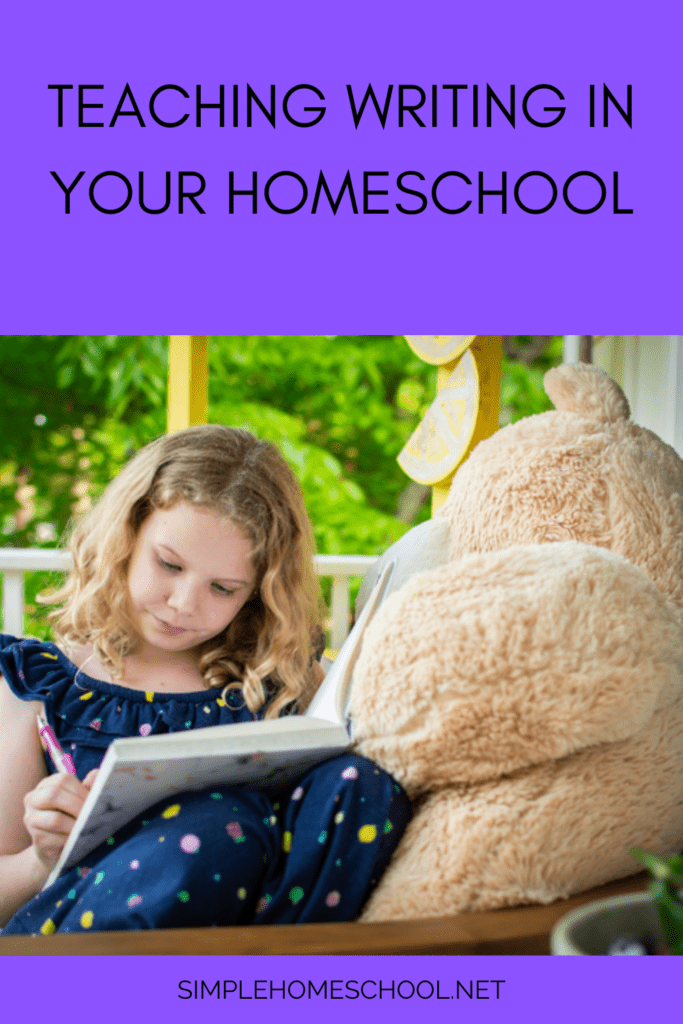
Teaching Writing in Your Homeschool ~
Written by Melissa Camara Wilkins
At our house this year, we’ll be homeschooling two high schoolers, one middle schooler, and an elementary schooler. Our oldest kiddo graduated from college last spring, and our next oldest has just moved back to school for his second year of college.
Which means I’ve been homeschooling one or more of our six kids for every one of the last seventeen years. Oh my.
Alongside our homeschooling adventures, I’m also an author – Have you read my book, Permission Granted? (afflinks). My husband was an English Literature major once upon a time, too. We’re all about words and language around here.
Not every one of our kids is going to grow up to be a writer, of course, but they all get to practice using their words in the meantime! Here’s how we’ve helped our kids on their homeschool writing journeys.
8 Tips for Teaching Writing in Your Homeschool
1. Read Lots of Everything
Reading is the best way that I know to teach writing.
Kids are learning about story structure and characterization and plot from reading, sure, but they’re also learning grammar, and spelling, and vocabulary, and sentence structure, and how to listen for the musicality of language. They’re absorbing so much, whether you’re reading aloud or they’re reading to themselves.
Our kids read all kinds of things: fiction, poetry, nonfiction, news (when they’re teenagers), even product packaging and advertisements (a form of persuasive writing!). They learn to write by seeing it done well first.
For kids who are still learning or who struggle with reading to themselves, audiobooks count as reading. Following along in a physical book as they listen can be helpful, too.
2. Take Dictation
Kids don’t need to know how to write their letters to be able to write stories or letters or ideas.
If your kids are still learning handwriting, or if the act of writing letters is still difficult, let them dictate their stories while you write them down.
Or try a dictation app or setting on your phone/computer. (Tip: read over the dictation app’s translation for accuracy—kid voices can be tricky for apps to understand, and those apps know a whole bunch of words that your kindergartener doesn’t. I’m just saying. ;))
3. Encourage Writing Just For Fun
Buy (or make) fun stationery or cards and encourage your kids to write letters to friends and relatives. Let them write stories on printer paper or in journals.
Or suggest that they create a story out of pictures, and then tell you what’s happening in each drawing.
4. Play Word Games
This could include word searches or Scrabble or Banangrams or Boggle, but also games like the license plate letter game: on the road, make up a phrase using the letters on a license plate as the first letters of your words. (Ignore the numbers.)
RDW in the middle of a plate becomes rhinos dancing wildly, or robots devouring wetlands, or raspberries dunking on wildebeests. You’re teaching your kids that words are tools they can use to create, even if they’re just creating quick, funny images.
5. Decide What They Need to Know
By the time my kids finish high school, we want them to have experience writing lots of different things, like short fiction, poetry, informational essays, persuasive essays, literary analysis, and MLA-style bibliographies.
But your goals might be different. Maybe you want to be sure your kid understands business communication. Maybe writing plays and skits is more important to your kid than writing short stories. Choose what’s important for your own family’s goals, and start there.
Please notice that I said by the time my kids finish high school! We don’t try to learn everything at once. And when they’re younger, reading and playing with words is our whole goal.
6. Use a Curriculum, or Don’t
We’ve tried a few different types of homeschool curricula for writing, and I’d love to hear about your favorites. But we haven’t found one that sticks for us.
We’re usually more comfortable deciding together what to learn next, then finding resources for learning that type of writing and giving it a try. Our resources might come from books, online videos, or just a parent explaining.
7. Expect Messy First Drafts
When we’re learning to do something new, we don’t do it perfectly the first time. Of course not!
So make sure your kids know they’re not meant to know how to do this yet, and that getting words (any words!) on the page is the first goal.
After that, they can decide how to revise to bring what they’ve written closer to their vision. But the first step is just to get anything out.
8. Edit Respectfully
Remember that writing is subjective, and that—unlike arithmetic—there’s no one right answer when it comes to a writing project.
Try to see what your writer is trying to create, rather than judging it against your ideas of what it should be. Praise the stuff your kids are doing well before pointing out what needs more work.
Not sure what to praise? Maybe point out their creative ideas, their voice, their interesting word choices, or even their careful spelling.

Our Favorite Writing Supplies
Want even more ideas? Here are our favorite writing supplies that may also come in handy as you’re teaching writing in your homeschool.
For Encouraging Play With Words
- Story cards: Create a story using images, like the ones on these fairy tale themed cards or on these animal village cards
- Story dice: Roll the dice and make up a story using the icons on the dice
- Letter dice: Make up sentences where each word starts with the letters you’ve rolled
- A library card, for checking out lots of different kinds of books
Wordy Board Games
Poetry Supplies
- Silly poetry books, like Shel Silverstein’s or Jack Prelutsky’s or the mischievous I’m Just No Good at Rhyming.
- Or poetry collections, like The Random House Book of Children’s Poetry.
- Magnetic poetry for the fridge or on a magnetic board. Take photos of your favorite creations.
For Young Kids (or Parents) Who Want More Structure
- Building Writers, a series of writing instruction workbooks from the same company that produces Handwriting Without Tears
- Wordly Wise for vocabulary (Though for a kid who struggles with words, this could easily feel overwhelming. Use your best judgment.)
For Middle Schoolers Who Want a Plan
For Kids Who Want to Be Writers
- Gail Carson Levine’s Writing Magic
- Spilling Ink: A Young Writer’s Handbook
- Avi’s A Beginning, A Muddle, and An End
For Teenagers
- Our friend Kara S. Anderson recommends this book for college prep: Wordsmith Craftsman
- To start learning to dissect what we read, try Reading Like a Writer, by Francine Prose, or the more accessible How to Read Literature Like a Professor: For Kids
- Khan Academy’s SAT Prep: Essay writing instruction and automatic essay scoring
- Spark Notes: Instruction and prep for writing literary analysis and for AP English tests
- Write the World is a free non-profit (writetheworld.org) for ages 13 – 19 to explore free writing prompts and join monthly writing competitions.
For High Schoolers Who Want an Online College Prep Class
- UC Scout offers accredited or self-study classes for English 9 – 12, AP English Language, and AP English Literature
Your Turn
How about you? How have you handled teaching writing in your homeschool? What are your favorite writing-related resources? Share with all of us in the comments!
This post contains affiliate links, which means Simple Homeschool receives a small commission from some of the links on this page.
What’s Your Child’s Learning Style? Take Jamie’s new quiz now and set yourself up for homeschooling success by understanding the way they learn best!



 Weekend homeschool links: August 19th
Weekend homeschool links: August 19th